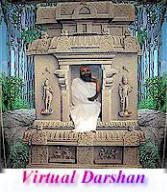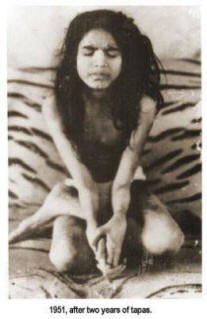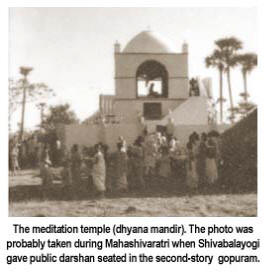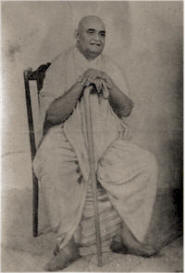|
|
|
The young yogi had so deeply impressed Satyanarayan Rao and Murthy that the two of them talked about the possibility of constructing a more permanent shelter, a sort of meditation temple (dhyana mandir) in which the yogi would be more comfortable. They discussed the idea of a permanent building with the zamindar (landowner) of the field in which Balayogi was sitting. The zamindar readily agreed to provide the land. With the blessings of Balayogi, Murthy took up the job of collecting donations to build a room.
As the small building was being constructed
nearby, Swamiji continued his tapas in the improvised hut with undiminished
intensity. He sat in samadhi motionless for twenty-three hours every day.
His hands and legs became stiff and wooden and he soon lost control of his
limbs. By August of 1950 when he completed his first year of tapas, the
young yogi found it almost impossible to move from his seat. He could no
longer walk to the canal to take his midnight bath, so people daily left him
a bucket of water outside his hut. With great difficulty and immense will
power and determination, he dragged himself to the bucket and washed
himself. Then he would drag himself back to his seat and resume his samadhi.
In spite of all this suffering, he carried on with his tapas undeterred for
almost a year in the improvised hut. By the time the new building was
finished, Swamiji was unable to walk and had to be carried to his new
meditation site.
Construction was finished around October of 1950. It was a twelve foot square, one room structure that became known as the dhyana mandir, the meditation temple. (The foundation of where the original dhyana mandir stood is now enclosed by the sanctuary of the Adivarapupeta temple.)
At that time there lived a saint popularly known as Tapaswiji Maharaj. He was a hatha yogi who had performed such austere tapas that he became known as Tapaswiji, a name meaning respected tapaswin, one who performs tapas. He had mastered the ayurvedic science of kaya kalpa: a regimen of samadhi, specially prepared herbs, silence, and complete isolation in a cool environment devoid of all light. Three times Tapaswiji underwent kaya kalpa and each time his aged body was restored to youthful vigor. He was 181 years of age when he first met Swamiji, and he dropped his physical body in 1955 at age 185. In January of 1951 he was in nearby Kakinada to inaugurate a new ashram. There he heard about a young balayogi doing tapas in the area and he expressed a desire to meet him. Tapaswiji came to Adivarapupeta and had darshan of the balayogi. Swamiji was in deep samadhi so Tapaswiji could not talk with him. Nevertheless Tapaswiji Maharaj immediately realized the high spiritual status of the yogi, then only sixteen years old. He devotedly placed some flowers at Swamiji's feet and instructed his companions to do the same. Tapaswiji was deeply impressed by this first darshan and he returned several more times. On one occasion Tapaswiji immersed himself in meditation to discover the yogi’s history. At once he recognized the incarnation of Lord Shiva in the young yogi, so when he emerged from his meditation, Tapaswiji prostrated before Swamiji, and worshipped him with flowers, exhorting his own devotees to do the same. Tapaswiji told his companions that Swamiji was a siddha purusha (a perfected soul) who had reincarnated of his own free will for the spiritual regeneration of mankind. He described Swamiji as the embodiment of the yoga of meditation and told them that in one of his former incarnations Swamiji was Shri Chandra, son of Guru Nanak and founder of the Udasi sect of samnyasins. In that birth, Tapaswiji Maharaj was one of Shri Chandra’s disciples. The venerable saint highly praised the spiritual status of Adivarapupeta Balayogi at a public meeting in Kakinada held in Tapaswiji’s honor. Tapaswiji told his audience that the Balayogi had been his guru in an earlier incarnation, and now was an avatar (divine incarnation) performing tapas to save mankind. Such praise from a highly revered saint like Tapaswiji Maharaj immediately increased the fame of Swamiji among the people of the area, and more people began to come to Adivarapupeta for his darshan. Saved from Starvation The intense meditation had changed Swamiji’s physical body so it could no longer tolerate ordinary food. Through the misguided influence of some, people generally came to think that he needed no nourishment while engaged in such long hours of meditation. Gradually the small offerings of food diminished or were taken away. Even after he moved to the field and the dhyana mandir was being built, neither his mother nor anyone else knew how to properly take care of a yogi undergoing tapas. Unknown to the villagers, Swamiji was gradually starving. It was Tapaswiji who recognized the starvation and saved Swamiji. During one visit, Tapaswiji told Swamiji how he had met a number of yogis in the Himalayas who were engaged in similar tapas. All of these yogis, he said, regularly took some food in limited quantities. He advised Swamiji to take a measured quantity of milk every day otherwise, Tapaswiji told him, it was very likely that his body would perish for want of nourishment within the next fifteen to twenty days. Before he left, Tapaswiji purchased a cow and presented it to Parvatamma so she could have an assured supply of milk for her son. |
 |
|
His Life |
| birth |
| childhood |
| childhood stories |
| enlightenment |
| beginning tapas |
| early obstacles |
| four directions |
| tapas completion |
| Adivarapupeta |
|
Ardhanarishwara Linga & Devi |
| India travels |
|
Banagalore ashram temple |
| Adivarapupeta ashram |
| in the West |
| mahasamadhi |
|
|
| yogi |
| religions |
| spiritual leaders |
| Jesus & Buddha |
| God |
| forms of God |
| guru-devotee |
| Swamiji's mission |
| initiation, vibhuti |
| meditation |
| samadhi (enlightenment) |
| tapas & Self realization |
| bhajans(devotional song) |
|
bhava samadhi (spiritual trance) |
| world conditions |
| foundation |
| Swamiji's words |
| Virtual Darshan |
|
|
|
Shri Shivabalayogi Maharaj
International Trust P.O. Box 293 Langley, WA 98260 U.S.A. info@Shiva.Org |
 The
news that Adivarapupeta Balayogi survived the deadly bite of a cobra spread
far and wide and soon reached the ears of the tax collector of the East
Godavari District. This man, Pillai by name, was a deeply religious. He
heard had heard that a balayogi in Adivarapupeta remained absorbed in
samadhi almost twenty-four hours each day. The additional news of surviving
the cobra bite made him want Balayogi’s darshan. Accordingly, the collector
set out for Adivarapupeta some time in January of 1950 accompanied by T. V.
Satyanarayan Rao and Garaga Narasimha Murthy.
The
news that Adivarapupeta Balayogi survived the deadly bite of a cobra spread
far and wide and soon reached the ears of the tax collector of the East
Godavari District. This man, Pillai by name, was a deeply religious. He
heard had heard that a balayogi in Adivarapupeta remained absorbed in
samadhi almost twenty-four hours each day. The additional news of surviving
the cobra bite made him want Balayogi’s darshan. Accordingly, the collector
set out for Adivarapupeta some time in January of 1950 accompanied by T. V.
Satyanarayan Rao and Garaga Narasimha Murthy.
 Tapaswiji Maharaj
Tapaswiji Maharaj